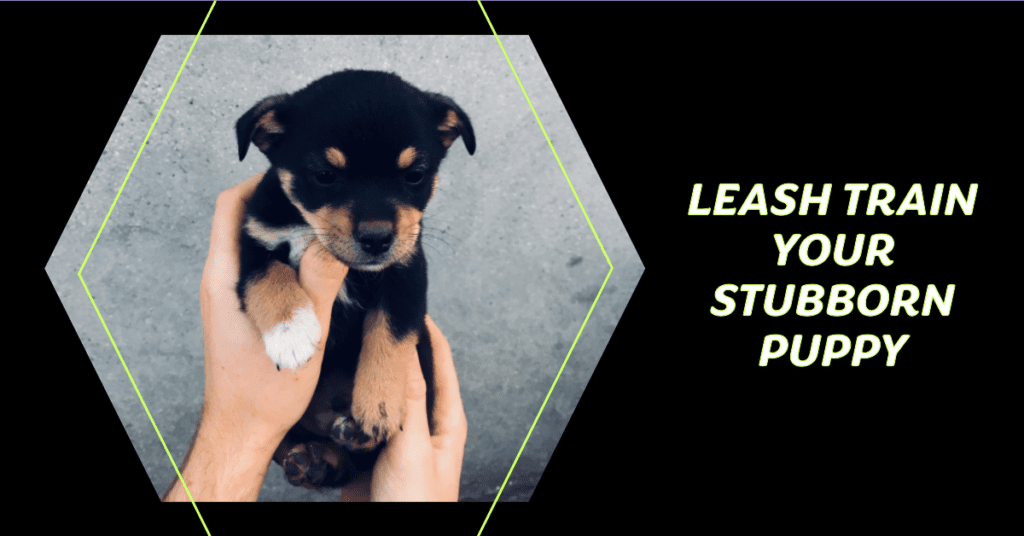Imagine having a playful and energetic puppy, but every time you try to take them for a walk, they just refuse to budge. It can be frustrating and leave you wondering How To Leash Train A Puppy That Won't Walk. In this article, you will discover effective strategies and tips on how to leash train a stubborn puppy that simply won't walk. From understanding their behavior to implementing positive reinforcement techniques, you'll soon have your puppy happily strolling alongside you in no time.
Understanding the Issue – How To Leash Train A Puppy That Won't Walk
Identifying the problem
If your puppy refuses to walk on a leash, it can be a frustrating and concerning issue. Leash training is an essential skill for any dog, as it allows you to keep them safe and under control when outside. Understanding the problem is the first step in addressing it and finding a solution.
Possible reasons for refusal
There can be several reasons why your puppy may be reluctant to walk on a leash. It could be due to fear or anxiety, discomfort with the leash and collar, unfamiliarity with the surroundings, or simply the puppy's stubbornness. By identifying the underlying cause, you can tailor your approach to leash training accordingly.
The importance of leash training
Leash training is not just about teaching your puppy to walk beside you; it encompasses safety, socialization, and overall well-being. A properly leash-trained puppy will be less likely to pull, lunge, or run away, reducing the risk of accidents and injuries. Additionally, leash training provides an opportunity for your puppy to interact with the outside world, exposing them to new environments, people, and animals.
Preparing for Leash Training
Choosing the right leash and collar
Selecting the appropriate leash and collar is crucial for successful leash training. There are various types of leashes available, such as standard nylon leashes, retractable leashes, or leather leashes. Consider factors like your puppy's size, strength, and behavior when choosing a leash. Similarly, the collar should fit comfortably and securely, without causing any discomfort or pain.
Ensuring proper fit
Once you have chosen a leash and collar, it is important to ensure a proper fit. The collar should be snug enough that it cannot slip over the puppy's head but loose enough to allow free movement. It is advisable to avoid collars that put pressure on the puppy's trachea, such as choke or prong collars, as they can be harmful and counterproductive for leash training.
Selecting a suitable location
When starting your leash training journey, it is crucial to choose a suitable location. Begin in a familiar and controlled environment, such as your backyard or a quiet park. Avoid crowded areas or places with excessive distractions, as they may overwhelm your puppy and hinder progress. Starting in a calm space will allow your puppy to focus and feel more at ease during the training process.
Building Positive Associations
Creating a positive environment
Creating a positive and comfortable environment is essential for successful leash training. Ensure that your puppy is in a calm state of mind before beginning the training session. Remove any potential distractions and make sure you have their attention. Encourage a positive atmosphere by maintaining a friendly and patient tone and using positive reinforcement techniques, such as treats and rewards.
Using treats and rewards
Treats and rewards are powerful tools when it comes to leash training. Use small, tasty treats that your puppy loves and reserve them solely for training purposes. Reward your puppy with a treat and praise each time they show positive behavior, such as approaching the leash or walking beside you. Consistent positive reinforcement will create a positive association with the leash and make the training experience enjoyable for your puppy.
Introducing the leash gradually
To ease your puppy into leash training, introduce the leash gradually. Start by simply placing the leash near them during playtime or mealtime, allowing them to sniff and investigate it. Once they are comfortable with its presence, attach the leash to their collar for short periods while indoors, gradually increasing the duration. This gradual introduction will help your puppy become familiar with the sensation of wearing the leash and reduce any potential anxiety or resistance.
Desensitization and Familiarization
Getting your puppy comfortable with the leash
Desensitization is a crucial part of leash training. Begin by attaching the leash to your puppy's collar and letting them roam around indoors while supervised. This will allow them to become accustomed to the sensation and weight of the leash. As they grow more comfortable, engage them in short play sessions, encouraging movement and exploration with the leash attached.
Starting indoors in a controlled space
In the initial stages of leash training, it is best to start indoors in a controlled space. Choose a room with minimal distractions and gradually increase the space available as your puppy becomes more comfortable. Begin by holding the leash loosely and allowing your puppy to explore at their own pace. Avoid pulling or putting tension on the leash, as it may create discomfort or resistance.
Gradually moving outdoors
Once your puppy is comfortable walking indoors with a leash, it's time to start venturing outside. Begin by choosing a quiet and familiar outdoor area, such as your backyard or a nearby park with minimal foot traffic. Allow your puppy to explore and walk on the leash, rewarding them for any positive behaviors. Gradually increase the duration and distance of the walks as your puppy gains confidence and familiarity with their surroundings.
Positive Reinforcement Techniques
Using clicker training
Clicker training can be an effective method for leash training. A clicker is a small device that makes a distinct clicking sound, signaling to your puppy that they have performed the desired behavior. Pair the sound of the clicker with treats and rewards, reinforcing positive associations with leash walking. Each time your puppy shows progress, click the device and offer a treat as a reward, solidifying their understanding of the desired behavior.
Rewarding small steps of progress
In leash training, it's important to celebrate and reward even the smallest steps of progress. If your puppy shows interest in the leash, approaches it willingly, or takes a few steps with it, praise them and offer a treat. By acknowledging and rewarding these small victories, you reinforce the positive behavior and motivate your puppy to continue learning and improving.
Consistency and patience
Consistency and patience are key when it comes to positive reinforcement training. Set aside regular training sessions each day, keeping them short and focused. Be patient with your puppy and understand that they may have setbacks or moments of resistance. Stay calm, provide reassurance, and persistently reinforce positive behaviors. Over time, your puppy will begin to associate the leash with rewarding experiences, making the training process smoother and more enjoyable.
Walking Exercises
Leash walking techniques
When it comes to leash walking, there are various techniques you can employ. One common technique is the “heel” command, where your puppy walks on your left side, matching your pace. Another technique is the “let's go” command, encouraging your puppy to walk forward with you. Experiment with different techniques to find what works best for you and your puppy's comfort and needs.
Practice loose leash walking
Teaching your puppy to walk on a loose leash is an important skill. Start by walking in a straight line while holding the leash loosely and allowing your puppy some freedom to explore. If they start pulling or tugging, stop moving and wait for them to relax before continuing. Reward them with treats and praise whenever they walk beside you with a loose leash. With consistent practice and reinforcement, your puppy will learn to walk calmly on a leash without pulling.
Handling distractions
While walking on a leash, it's inevitable to come across various distractions, such as other dogs, noises, or squirrels. Teaching your puppy how to handle distractions is crucial for their safety and your control. Start by gradually exposing them to different distractions, maintaining a calm and composed demeanor. Use treats and rewards to redirect their attention back to you and reinforce positive behavior. With time and practice, your puppy will become more focused and responsive even in the presence of distractions.


Problem Solving
Overcoming fear or anxiety
If your puppy displays fear or anxiety towards the leash, it is important to address these emotions before progressing further. Take a step back and focus on building a positive association with the leash through treats, rewards, and gradual desensitization. Allow your puppy to investigate and approach the leash at their own pace, avoiding any forceful or sudden movements that may increase their fear. Seek professional help if the fear or anxiety persists or worsens.
Dealing with pulling or tugging
Pulling or tugging on the leash is a common challenge during leash training. When your puppy starts pulling, it is essential to stop and wait for them to relax before continuing. Avoid pulling back on the leash, as it may escalate the pulling behavior. Instead, change direction or call your puppy's attention to redirect their focus back to you. Consistency in enforcing the “heel” or “let's go” command, along with rewards for loose leash walking, will help discourage pulling behaviors.
Addressing stubbornness
Stubbornness is another challenge that might arise during leash training. If your puppy refuses to walk or consistently resists following your lead, it's important to stay patient and consistent. Utilize treats, rewards, and positive reinforcement to encourage the desired behavior. Additionally, incorporate short training sessions throughout the day to keep your puppy engaged and focused. Avoid punishment or forceful tactics, as they can induce fear or aggression, making the training process even more challenging.
Socialization and Exposure
Introducing your puppy to new environments
Leash training presents an excellent opportunity to introduce your puppy to new environments. Gradually expose them to different places, such as parks, streets, or outdoor cafes. Allow them to explore, sniff, and observe their surroundings while maintaining control on the leash. This exposure will help your puppy become accustomed to diverse environments and reduce any future anxiety or fear when encountering new places.
Encouraging interaction with other dogs
Socializing your puppy with other dogs is an integral part of their development. While on leash walks, look for opportunities to safely introduce your puppy to other friendly and vaccinated dogs. Allow them to interact and play under supervision, ensuring positive experiences and interactions. Socialization not only enhances your puppy's social skills but also promotes a positive attitude towards leash walking and outdoor activities.
Gradually exposing to different stimuli
In addition to other dogs, it's essential to gradually expose your puppy to various stimuli to ensure they remain calm and focused on the leash. Introduce them to different sounds, such as traffic noise or construction sounds, and gradually increase the level of exposure. Similarly, expose them to a variety of sights, smells, and textures, helping them become more adaptable and confident in different environments.
Professional Training Assistance
Considering professional help
If your puppy's refusal or resistance to leash training persists despite your best efforts, considering professional help is a viable option. A professional dog trainer with experience in leash training can provide guidance, assess your puppy's behavior, and offer tailored solutions to address any underlying issues. They can also provide additional training techniques and strategies that you may not have considered.
Finding a reputable dog trainer
When seeking professional assistance, it is crucial to find a reputable and qualified dog trainer. Look for trainers who have experience and certifications in positive reinforcement training methods. Ask for recommendations from friends, family, or your veterinarian. Ensure the trainer's philosophy aligns with your own values and goals for your puppy's training. A good trainer will provide ongoing support and guidance throughout the leash training process.
Alternative training methods
In some cases, traditional leash training methods may not be effective for certain puppies. If your puppy continues to exhibit resistance or fear towards leash training, consider alternative methods, such as harness training or using a long line for added freedom and exploration. Consult with a professional trainer to explore different training techniques and find the approach that suits your puppy best.
Importance of Consistency
Establishing a routine
Consistency is key to successful leash training. Establishing a regular routine with structured training sessions will help your puppy understand what is expected of them. Set aside dedicated time each day for leash training, ensuring that you and your puppy are in the right mindset and environment. Consistency in training will not only accelerate progress but also strengthen the bond between you and your puppy.
Reinforcing positive behavior
Consistently reinforcing positive behavior is crucial for maintaining progress in leash training. Reward your puppy with treats and praise whenever they exhibit desirable behavior, such as walking calmly on a loose leash or responding to commands. Reinforcing positive behavior will strengthen the association between appropriate behavior and rewards, encouraging your puppy to repeat those behaviors in the future.
Avoiding punishment
It is important to avoid punishment during leash training. Punishing your puppy for unwanted behavior can create fear, anxiety, and resistance, hindering the training process. Instead, focus on positive reinforcement and redirecting their attention to desired behaviors. If your puppy makes a mistake or exhibits unwanted behavior, stay calm and patient, reassuring them and redirecting their focus back to the training process.
Leash training may require time, patience, and dedication, but the benefits are worthwhile. By understanding the issue, preparing properly, and employing positive reinforcement techniques, you can successfully leash train your puppy. Remember to prioritize their comfort, focus on positive associations, and seek professional help when needed. With consistency and perseverance, your puppy will become a confident and well-behaved companion on walks. Happy training!





